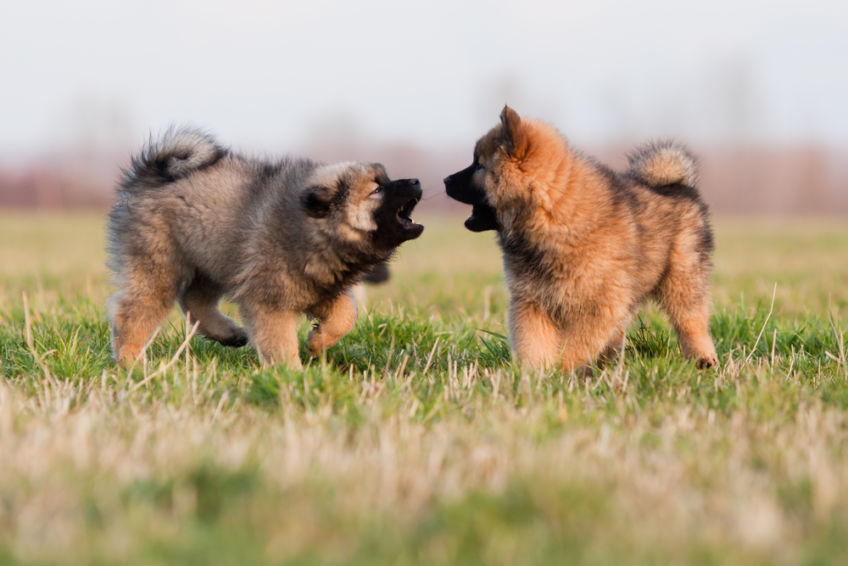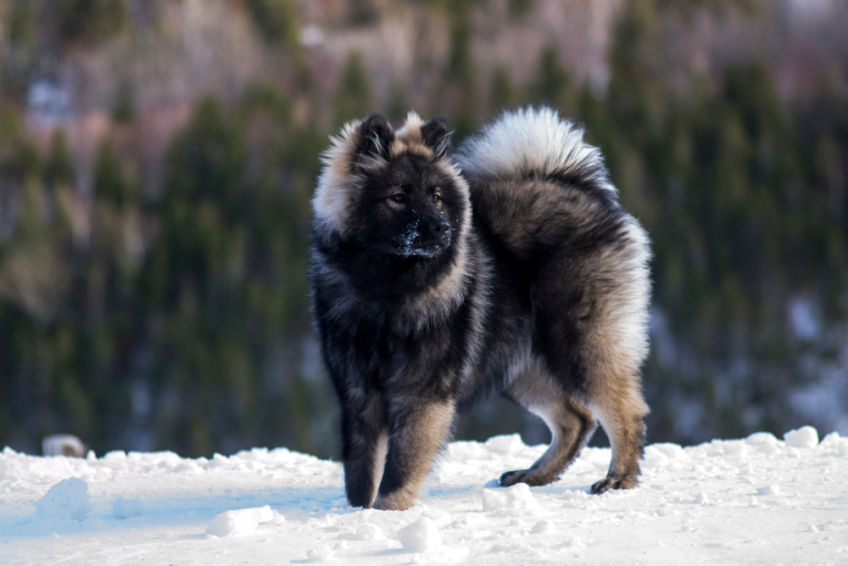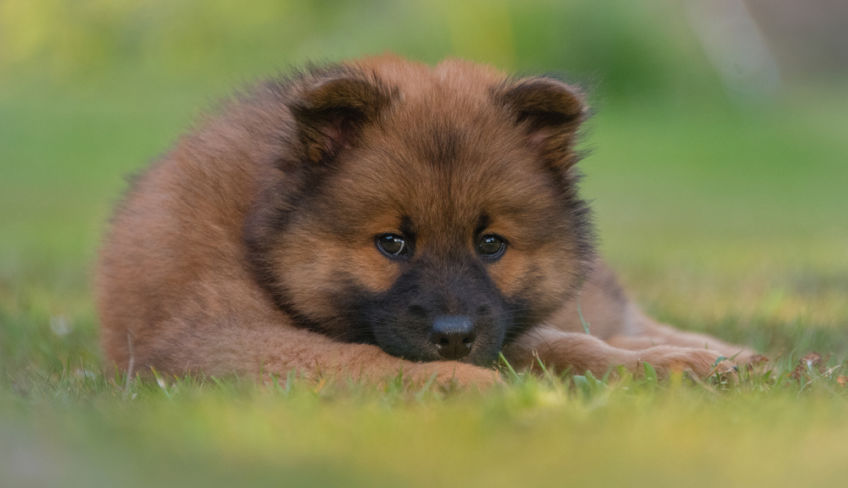Eurasier is a medium-sized, richly hairy spitz dog with a fairly typical appearance, with a tail curled back and ears standing alertly. A dog with a moderate desire to cooperate with people, rather calm but alert. Hardly noisy
Nature
Eurasiers are calm and balanced dogs. At the same time, they are vigilant and guard well, show distance to strangers, but are not fearful or aggressive. They are strongly attached to their family. However, for these predispositions to be fully revealed, Eurasier needs close, constant contact with the family and basic training.
At home, eurasiers are quiet and not absorbing, lively for walks, they willingly take on various activities. They are not barking. If they are barking, it is because they have a good reason to do so. Of course, they require a certain amount of movement and activity – they should be able to satisfy their natural curiosity and need for exploration to fully calm down at home.

In relation to foreign dogs, they are usually trouble-free, as long as they are properly socialized at a young age and do not have any negative experiences. They are not very herd, but at home they get along with a second dog. They also accept other pets. They get along great with children, they are great play companions. Of course, it’s worth remembering that we never leave small children alone with the dog, because kids have very strange ideas …
Skills
Eurasier was bred as a family dog and this is the role in which he works best. He is also a good watchman, but it is advised not to keep him permanently in the pen, without close contact with his family. Character makes Eurasiers a good material for therapeutic dogs, although of course not every individual is suitable for this.

Training and education
Eurasiers are very sensitive to sharp tone or so-called “Hard hand”. A gentle but consistent approach works best for these dogs. They are intelligent dogs, they learn quickly and willingly, although sometimes they are a bit stubborn. Because they were bred as family dogs, they not only endure harsh treatment badly, but also isolation from people, such as confinement in a pen. They should not be returned to the so-called stationary training – a family member should take care of the training personally. The acceptance of the guide is very important to them, so they respond perfectly to praise. Eurasiers are eager to take part in all activities with their family, and also prove themselves in amateur dog sports.

Who is this race for?
Eurasier works well as a companion dog for various people, but he can’t stay alone for long without contacting his family. Isolated for a long time from a man, he dies from longing, he loses the joy of life. It is not suitable for people with hard hands or those who want to have a dog that is absolutely obedient, like a robot responding to commands.
Advantages and disadvantages
Eurasier – what is it like? Learn its pros and cons!
Disadvantages
- can be a bit stubborn
- very sensitive, badly tolerates sharp approach
- badly tolerates long-lasting isolation from man
- moults abundantly
Advantages
- excellent companion dog
- adapts to the owner’s lifestyle
- good watchman
- is not aggressive
- great buddy for kids
- non-conflict with other dogs
- deprived of hunting instincts
Health
Eurasiers generally enjoy good health, although the small gene pool at the beginning of the breed caused them to have a tendency to some diseases. There is dysplasia, patella prolapse, hypothyroidism, as well as eyelid problems: distichiasis (abnormal eyelash growth towards the eye), entropy and ectropion.

nourishment
Eurasier makes good use of feed and has no extraordinary nutritional requirements. Food should be tailored to his needs (age and activity).
Care
Eurasiers have a double-layered coat with an abundant undercoat, which is why they moult profusely, usually twice a year. But it can also happen that the eurasier loses his hair all year round. The coat is easy to care for, because it has self-cleaning properties, but requires regular brushing, especially during molting. We bathe the dog when the situation requires it, i.e. when it is dirty, possibly before the exhibition. Before the exhibition, it is also worth arranging the hair at the ears (cut too long, trim the dead) and on the paws (cut so that it does not protrude). In addition, however, eurasier is simply to be clean, tidy and look natural.

Accessories
Powder brush is suitable for regular eurasier care. During the molting period, a furminator brush or hook trimmer can be used to remove more undercoat.
History
Eurasier is a young Spitz breed that was bred in Germany. In the 1950s, the Wipfel decided to create the perfect family companion dog. Julius Wipfel is considered to be the “father” of the breed, but he was helped by a group of breeders-enthusiasts who jointly tried to realize this dream. One of them was, among others Charlotte Baldamus.

In 1960, Wipfel clearly stated the goals that guided him in creating a new breed. He wanted to create a medium-sized family dog in the form of a spitz, awakening some respect, but with a calm and balanced temperament. This dog was supposed to have an attractive appearance and a beautiful coat of different color. He had to adapt easily to different lifestyles of carers, feel good both in the countryside and in the city.
The initial plan assumed mating within a group of selected wolf spitz and chow-chow , the latter looking different at the time – they were just like today’s eurasiers. The breed was initially called wolf-chow. Later, in 1972, after stormy discussions among the leading enthusiasts of the new race, Wipfel decided to enrich the mixture with a self-drive . Shortly thereafter, the breed was recognized by the German Kennel Club (VDH) and FCI (in 1973) and named Eurasier.

In 1996, under the auspices of FCI, the International Federation for Eurasier Breeding (IFEZ) was founded – an organization that cares about the nature and health of the breed. Club members from some countries are members of this organization. Since 1999, puppies bred in accordance with the requirements of this organization have received a special certificate issued by the national club along with the pedigree.
Eurasier in Poland
The breed enjoys moderate popularity in the world. Most eurasiers are in the country of origin. There is some breeding in Poland, although the breed is generally little known. The first kennel operating in Poland is Lupus Ferratus, which deals with the breed since 2009.
Eurasier – group V FCI, section 5, reference number 291
- Country of origin: Germany
- Character: confident, calm, balanced, with a high excitability threshold; watchful and alert, but not noisy; very attached to his family; restrained towards strangers, but not aggressive; lack of hunting instinct; To fully develop the above-mentioned qualities, the Eurasier requires constant, home closeness with his family and forgiving but consistent upbringing.
- Size: dogs 52-60 cm, bitches 48-56 cm
- Weight: dogs 23-32 kg, bitches 18-26 kg
- Coat: thick undercoat and medium length all over the body, loosely lying topcoat; short hair on the muzzle, face, ears and forelegs; tail, back of the front legs (feathers) and hind legs (pants) – covered with long hair; coat on the neck only slightly longer than on the torso; does not create a mane.
- Color: all colors and combinations of colors – acceptable, except for pure white, white patches and liver color; in practice, eurasiers come in various shades of red (to pale cream, almost white), with or without black coating, wilted, black and tan and pure black.
- Lifespan: 12-15 years
- Vulnerability to training: high; although it belongs to primitive breeds, it is relatively easy to shape
- Activity: medium; he likes movement, but if he is given regular walks, he will adapt to a less active lifestyle
- Cost of living:
- Resistance / susceptibility to diseases: very resistant to cold and frost, does not tolerate heat very well; rather healthy breed, although dysplasia, patella prolapse, thyroid problems and eyelid defects occur
- Possibility to buy a puppy: a puppy usually needs to be ordered
- Price of a dog with a pedigree:
Interesting facts
Eurasiers together with chow-chow and bobtails were used to create another breed of family dogs – elo. This breed is not yet officially recognized.
The Nobel laureate and creator of ethology Konrad Lorenz bought a Eurasier bitch with a pedigree name Nanette von Jaegerhof from Charlotte Baldamus, whom he called Babette. The professor considered her character as the best possible for a domestic dog.
One of the proposals for the new breed name when they wanted to change it was the name lorentiner, in honor of Konrad Lorenz. This breed was supposed to fulfill the dog’s ideal that the professor dreamed of – for a long time he thought that most dogs, including European Spitz, came from the golden jackal , and only a few from the wolf , including his beloved chow-chow. However, genetic studies have clearly shown that jackals are certainly not the ancestors of domestic dogs, and all dogs are derived from wolves, although they could have been some other subspecies, nonexistent today.
